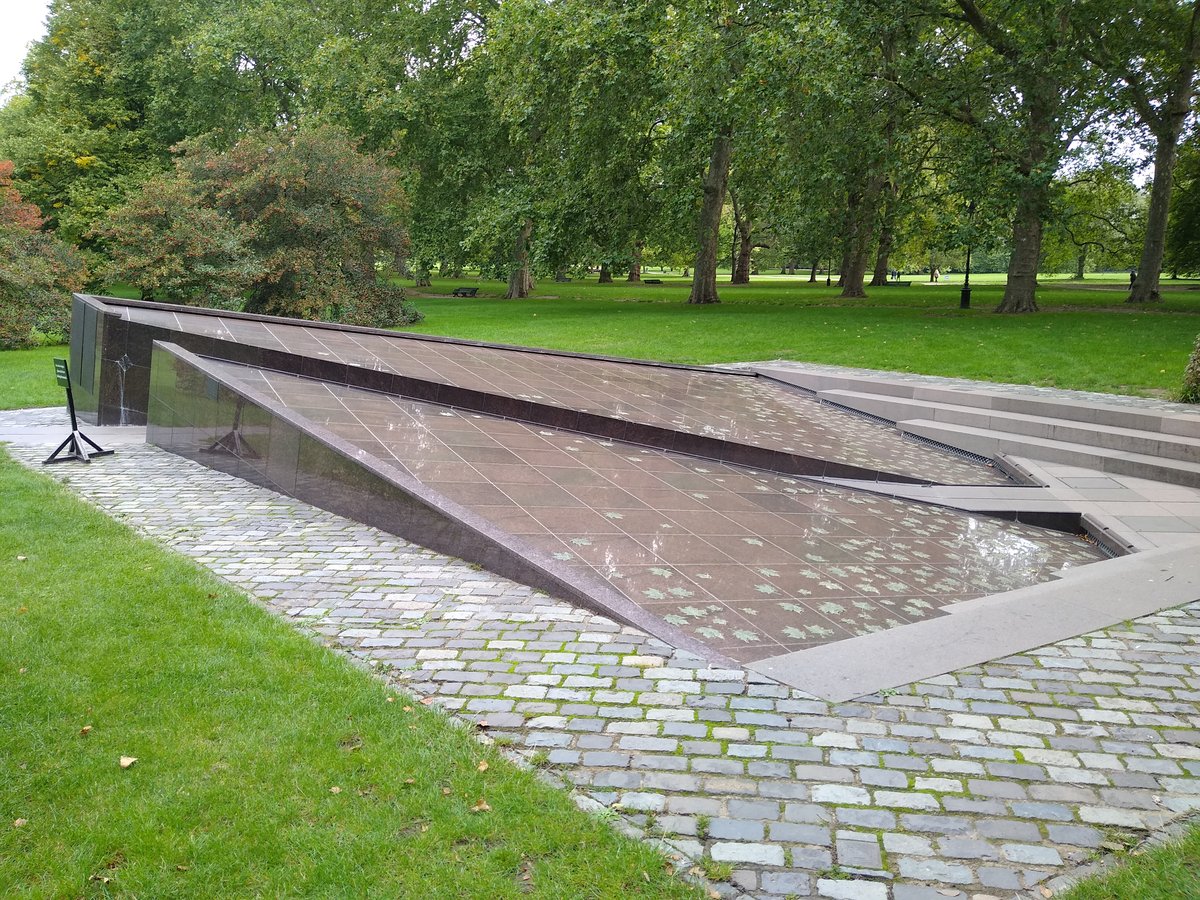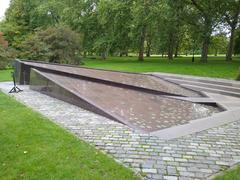
Canada Memorial London: Visiting Hours, Tickets, and Complete Travel Guide
Date: 15/06/2025
Introduction
The Canada Memorial in London stands as a profound tribute to over one million Canadians who served with British forces during the First and Second World Wars. Located in Green Park near Buckingham Palace and the historic Canada Gate, the memorial is a lasting symbol of the enduring friendship and shared sacrifices between Canada and the United Kingdom. Conceived through cross-Atlantic collaboration and public initiative, its thoughtful design and accessible setting make it an essential destination for history enthusiasts, tourists, and those wishing to honor Canadian heritage in London. This guide provides a comprehensive overview of the memorial’s history, symbolism, visitor information, travel tips, and nearby attractions to help you plan a meaningful visit.
Table of Contents
- Historical Background and Establishment
- Fundraising, Planning, and Design
- Construction and Artistic Symbolism
- Unveiling, Dedication, and Legacy
- Visiting Hours, Tickets, and Accessibility
- Travel Tips and Visitor Experience
- Nearby Attractions and Amenities
- Special Events and Guided Tours
- Frequently Asked Questions (FAQs)
- Summary and Visitor Tips
- Sources and Further Information
Historical Background and Establishment
The concept for the Canada Memorial was born in 1988 following a public call in a British newspaper to honor the immense Canadian contribution to the World Wars (Canada Memorial Foundation). This initiative quickly gained momentum, leading to the formation of the Canada Memorial Foundation in 1991, spearheaded by Canadian-British businessman Conrad Black. The Foundation initially focused on fostering academic exchanges before turning its attention to the creation of a permanent memorial in London (Wikipedia).
Fundraising, Planning, and Design
Significant cross-Atlantic collaboration and fundraising efforts were vital to the memorial’s realization. Both private and public sectors contributed, with notable support from Canadian government officials, including then-Prime Minister Jean Chrétien (London Remembers). An international design competition in 1992 led to the selection of Quebec sculptor Pierre Granche, whose proposal elegantly combined artistic vision with deep national symbolism (Canada Memorial Foundation).
Construction and Artistic Symbolism
Materials and Structure
The memorial is constructed from hundreds of pieces of red granite quarried on Anticosti Island in Canada, symbolizing Canadian strength and heritage. Embedded within the sloped granite surface are 506 bronze maple leaves—Canada’s national emblem—cast in Quebec (Canada Memorial Foundation). A narrow walkway divides the monument, its alignment pointing toward Halifax, Nova Scotia, the main port of departure for Canadian troops in both World Wars (Royal Parks; London Remembers).
Symbolism
Water gently flows over the granite, creating the illusion of maple leaves floating down a stream—a metaphor for the passage of time and remembrance. The bilingual inscription at the memorial’s heart reads:
“In two world wars one million Canadians came to Britain and joined the fight for freedom. From danger shared, our friendship prospers.”
This message, along with the artistic elements, honors both the national identity of Canada and the shared history with Britain (Veterans Affairs Canada).
Unveiling, Dedication, and Legacy
The Canada Memorial was unveiled by Queen Elizabeth II on June 3, 1994, in the presence of dignitaries, veterans, and the public (London Remembers). Its prominent placement near the Canada Gate and Buckingham Palace ensures high visibility and accessibility. After initial years of maintenance challenges, responsibility for the memorial’s care was assumed by the Canadian government in 2008, ensuring its preservation as a lasting tribute (Wikipedia).
Visiting Hours, Tickets, and Accessibility
Hours:
The Canada Memorial is outdoors in Green Park, accessible daily from 5:00 am until midnight. There are no admission fees or ticket requirements.
Accessibility:
The site is wheelchair accessible, with smooth, gently sloped paths. Green Park Underground Station (Piccadilly, Jubilee, Victoria lines) is the nearest public transport stop, just a short walk from the memorial.
Travel Tips:
- Wear comfortable shoes for walking in the park.
- Early morning or late afternoon visits offer a quieter, more contemplative experience.
- Restrooms are available near main park entrances; benches are scattered throughout for rest and reflection.
Travel Tips and Visitor Experience
Location:
Green Park, adjacent to the Canada Gate and Buckingham Palace (Britain Express). The memorial’s alignment toward Halifax, Nova Scotia, adds a poignant connection to Canadian history.
Atmosphere:
Green Park’s tranquil setting provides a peaceful environment for reflection. The memorial’s design, with its flowing water and tactile bronze leaves, invites visitors to engage both visually and emotionally.
Best Times to Visit:
June offers mild to warm weather and extended daylight. Early mornings and late afternoons are less crowded. The park can be busier on weekends and during royal events (Global Highlights).
Nearby Attractions and Amenities
- Buckingham Palace: Located just south of the memorial; tours available seasonally.
- Canada Gate: An ornate entrance facing Buckingham Palace, featuring provincial crests of Canada.
- Wellington Arch and Hyde Park Corner: Short walks away, offering additional memorials and historical sites.
- St. James’s Park: Adjacent to Green Park, ideal for further exploration (Britain Express).
Facilities:
Benches throughout the park; public toilets near main entrances; free public Wi-Fi in many areas of central London (London Drum).
Special Events and Guided Tours
Annual Remembrance Day ceremonies on November 11 and other commemorative events are held at the memorial, often attended by officials, veterans, and the public (Veterans Affairs Canada). While there are no official guided tours specifically for the Canada Memorial, many London walking tours covering war memorials include it as a highlight (Royal Parks).
Frequently Asked Questions (FAQs)
Q: Are tickets required to visit the Canada Memorial?
A: No, entry is free and no tickets are required.
Q: What are the memorial’s visiting hours?
A: Green Park is open from 5:00 am to midnight; the memorial is accessible during these hours.
Q: Is the memorial wheelchair accessible?
A: Yes, all pathways to the memorial are suitable for wheelchairs and strollers.
Q: Are guided tours available?
A: The memorial is included in some walking tours of London’s historical sites.
Q: Can I take photographs?
A: Yes, photography is permitted, but please be respectful during moments of remembrance.
Q: Are there commemorative events?
A: Yes, especially on Remembrance Day and World War anniversaries.
Summary and Visitor Tips
The Canada Memorial in London is a moving and accessible site commemorating the service and sacrifice of Canadian forces during the World Wars. Designed by Pierre Granche, its artistic features—the red granite, bronze maple leaves, flowing water, and alignment toward Halifax—offer deep symbolism. Located in the serene Green Park and close to major landmarks, the memorial is ideal for quiet reflection and historical exploration.
Plan your visit during daylight hours to experience the memorial’s full impact, and consider combining it with nearby attractions such as Buckingham Palace and the Canada Gate. Download the Audiala app for audio guides and use official websites for the latest information on events and accessibility.
Sources and Further Information
- Canada Memorial Foundation – History
- Waymarking.com – Canada Memorial, Green Park, London
- Military History Fandom – Canada Gate and Canada Memorial
- Britain Express – Green Park and Canada Memorial
- Veterans Affairs Canada – Commemorative Events
- Royal Parks – Canada Memorial
For an enriched visit, download the Audiala app for self-guided tours, and connect with us on social media for updates on commemorative events and new content about London’s historical sites.




















































































































































































































































